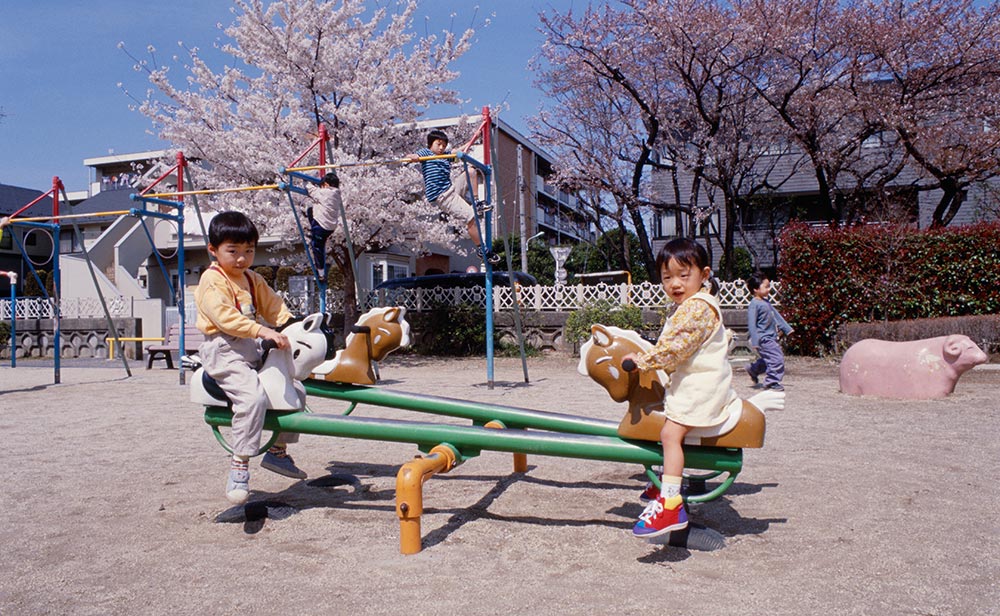NIKKOR - The Thousand and One Nights No.15

<New> Zoom Nikkor 28-45mm F4.5
The eleventh Tales discussed a large-aperture, super telephoto lens NIKKOR-H 300mm f/2.8 made exclusively for news photographers. In the Tale Thirteen, I discuss about the Reflex-Nikkor 500mm f/8 (New) which will be more familiar to amateur photographers within super telephoto lenses.
In the Tale Fifteen, I discuss about the world's first genuine wide-angle zoom lens, (new) Zoom Nikkor 28-45mm f/4.5. The lens was the origin of standard wide-angle zoom lenses that Nikon (Nippon Kogaku K.K.) has been developing for many years.
by Haruo Sato
I. Features and history of the lens

Nikon's first standard wide-angle zoom lens for SLRs was the short-lived standard zoom lens, Auto NIKKOR WIDE ZOOM 3.5-8cm f/2.8-4 (announced in 1961) which was introduced in the Tale Four.
The lens designed by MR. HIGUCHI, Takasi was a revolutionary product insofar as it was the first ever lens of the negative-positive 2-group zoom type which is now the bench mark configuration for today's standard and wide-angle zoom lenses. Regrettably, the lens has never produced on a commercial basis. However, the product of the study was not wasted. Taking this opportunity, pioneers of lens design were gradually absorbed by the study of wide-angle zoom lenses.
In consequence, the (new) Zoom Nikkor 28-45mm f/4.5 came onstage in August 1975 with the crown of the "world's first genuine wide-angle zoom lens". For all the really compact lens barrel, the lens completely overcame distortion which had been a nerve of a zoom lens.
Expert Japanese designer is generally little known outside the industry, but his achievement can be traced through his countless reports and patents. Now, let's go back to the history of development. Development of the (new) Zoom Nikkor 28-45mm f/4.5 was carried out by Mr. NAKAMURA, Souich of 2nd Optical Section, Optical Designing Department (then). Mr. NAKAMURA was one of forerunners of zoom lens designers in Nikon. He was the one who most absorbed knowledge for designing zoom lenses from Mr. HIGUCHI who was the designer of the Zoom-NIKKOR Auto 43-86mm f/3.5 which was known in Japan as the "yon-san-hachi-roku", literally the "four-three-eight-six".
The lens was completed its design in May 1970, when trees put out leaves. Patent applications were submitted almost the same period. Then, U.S. Patent was granted in 1973, and Japanese Patent in 1974. Reading the patent documents, I was amazed that he seemed to have suggested a negative-positive-negative-positive 4-group zoom which is the mainstream of the current super-wide-angle zoom lens. The zoom type research of Mr. NAKAMURA was really ahead of his times.
While favorably proceeding trial manufacture, mass production plans were issued in winter of 1972. Finally, the fruit of pioneers' passion and industry was released in August 1975. The world's first genuine wide-angle zoom lens, "Zoom Nikkor 28-45mm f/4.5" came onstage as a so-called "New Nikkor Lens" with a newly designed lens barrel and multi-coating. Afterwards the lens was reborn with an AI system (Automatic Maximum Aperture Indexing System) in June 1977 to be an "AI Zoom Nikkor 28-45mm f/4.5".
Later, the world's first wide-angle zoom lens terminated its role when the "AI Zoom Nikkor 25-50mm f/4" was released in 1979.
In view of global trend, this period particularly was the genesis of zoom lenses. Designing skill refined here spread over the business community without remaining in the company.


Mr. NAKAMURA's achievement was striking and his lens design was not limiting to the wide-angle zoom lens. He designed, for example, the "ZOOM-NIKKOR Auto 80-200mm f/4.5 (1970)" which established a unique afocal-zoom type, and the "(new) Zoom-Nikkor ED360-1200mm f/11 (1976)" which was a telephoto zoom lens.
To tell the truth, the IF (Internal Focusing) system for super-telephoto lenses was also designed by three people, Mr. NAKAMURA at the head of the list, Mr. ARASHIDA, Kazuo, and Mr. HAYASHI, Kiyoshi.
It is no exaggeration to say that the invention carrying out focusing by moving only a portion of lens element in the lens system not by moving the whole lens elements laid the foundations of current super-telephoto lens systems. The origin of the entire IF type super-telephoto lens systems was here regardless of inside or outside of the company. Getting credit for the achievement, the three inventors awarded the president prize of JIII (Japanese Institute of Invention and Innovation) in 1994 with the Imperial Family and administration officials watching. I would like to save the story for another Tale.
II. Lens performance and imaging characteristics

First of all, I will explain briefly the fundamental configuration of the wide-angle zoom lens. The lens has a negative-positive-positive 3-group zoom type as shown in Fig. 1.
A first three lens elements composed of a negative lens element having a large diameter and a cemented lens constructed by a positive lens element cemented with a negative lens element have negative refractive power as a whole.
A rear lens group including an aperture stop makes a so-called "master lens" having configuration of a positive-negative-positive triplet type.
If you feel something instinctively at this point, you are sharp. The configuration is exactly the retrofocus type. In plain words, it is no exaggeration to say that zoom lens configuration is formed by moving separately the negative and the positive lens groups which are the basic configuration of the retrofocus type.
In the Zoom Nikkor 28-45mm f/4.5, astigmatism and curvature of field at each focal length are optimized by separating the rear lens group (master lens group) into two groups and moving the two lens groups separately. This is an example that the close-range aberration fluctuation explained in the Tale Fourteen, "NIKKOR Auto 24mm f/2.8", is applied to a zoom lens.
What are the imaging characteristics of the zoom lens ? Let's take a look at how this lens performs from both aberration characteristics and results of actual shot.
When you look at aberration values, you may notice very small coma flare over the entire image field. Accordingly, you can expect the lens to have high contrast and clear image rendition. It is shown that astigmatism is small except in the extreme periphery and chromatic aberration corrected satisfactory. This characteristic makes you feel that the lens has clear crisp imaging rendition without peculiarity.

Nikon F2, Zoom Nikkor 28-45mm f/4.5 (shot by f=28mm), f/11, 1/500 sec., Kodak EB II
(Shooting data is the same as Examples 2 and 3)
©2001-2003 SATO, Haruo

©2001-2003 SATO, Haruo
Please take a look at Examples 1 and 2. Both pictures are shot under flat lighting. You may recognize moderate contrast and good color reproduction.

©2001-2003 SATO, Haruo

Nikon F2, Zoom Nikkor 28-45mm f/4.5 (shot by f=28mm), f/11, 1/500 sec., Kodak EB II
(Shooting data is the same as Examples 2 and 3)
©2001-2003 SATO, Haruo
Then, please take a look at Examples 3 and 4. Although both pictures are shot under full back lighting, in cooperation with good coating, very clear, high contrast, and crisp image rendition can be seen.
It is worth of special mention that distortion is amazingly small. Distortion at 28mm is actually less than -1.8% (when focusing at infinity). They say that it becomes noticeable when negative distortion exceeds -2.5%. This vale in the "28-45mm f/4.5" zoom lens is no way inferior to fixed focal length lenses.
Please take a look at Example 4. I intentionally chose an object on which distortion was easy to be noticed. Although the object is extremely sever for a zoom lens, you may not recognize any distortion.
Why did Mr. NAKAMURA so completely remove distortion ? Because it was so difficult that nobody has ever achieved in zoom lens designing. Mr. NAKAMURA finally broke through the problem. He must have been happy.
Mr. NAKAMURA, Souichi
Mr. NAKAMURA, usually, was a man who was full of vigor and pushed positively forward everything having good lungs and loud steps. His dashing foot steps through a passage could be heard from every corners of our office.
Mr. NAKAMURA who was serious about everything, laughed out loud, and got angry once in a while had a passionate profile keeping high state even in off time.
Let me introduce his youthful episode. It is pretty common now for us to take a paid vacation as a paid worker's right throwing our chest out. In those days, however, we used to be asked reason from our boss whenever submitting a request for a single day off. Mr. NAKAMURA unexpectedly submitted a request for a vacation for 1 whole week. His coworkers were dying of curiosity.
As a matter of fact, Mr. NAKAMURA was a ardent "Wagnerian". In those days in Japan, it was very rare that Wagner's famous three-decker musical drama "Der Ring Des Nibelungen" was performed for four consecutive nights. The golden chance came to Mr. NAKAMURA. The news that authentic players were coming to KANSAI (western part of Japan) from Germany must have made him anxious to go to the concert.
Later, when I asked Mr. NAKAMURA how the concert had been, he answered with a smile, "Well, I fell asleep unconsciously."
When I heard that, involuntarily I smiled wryly feeling as if I could peek at a part of Mr. NAKAMURA's personality.
He must have been exhausted himself from daily hard work.

NIKKOR - The Thousand and One Nights
The history of Nikon cameras is also that of NIKKOR lenses. This serial story features fascinating tales of lens design and manufacture.

